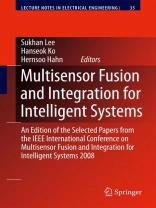The ?eld of multi-sensor fusion and integration is growing into signi?cance as our societyisintransitionintoubiquitouscomputingenvironmentswithroboticservices everywhere under ambient intelligence. What surround us are to be the networks of sensors and actuators that monitor our environment, health, security and safety, as well as the service robots, intelligent vehicles, and autonomous systems of ever heightened autonomy and dependability with integrated heterogeneous sensors and actuators. The ?eld of multi-sensor fusion and integration plays key role for m- ing the above transition possible by providing fundamental theories and tools for implementation. This volume is an edition of the papers selected from the 7th IEEE International Conference on Multi-Sensor Integration and Fusion, IEEE MFI‘08, held in Seoul, Korea, August 20–22, 2008. Only 32 papers out of the 122 papers accepted for IEEE MFI’08 were chosen and requested for revision and extension to be included in this volume. The 32 contributions to this volume are organized into three parts: Part I is dedicated to the Theories in Data and Information Fusion, Part II to the Multi-Sensor Fusion and Integration in Robotics and Vision, and Part III to the Applications to Sensor Networks and Ubiquitous Computing Environments. To help readers understand better, a part summary is included in each part as an introduction. The summaries of Parts I, II, and III are prepared respectively by Prof. Hanseok Ko, Prof. Sukhan Lee and Prof. Hernsoo Hahn.
Tabella dei contenuti
Theories in data and information fusion.- Performance Analysis of GPS/INS Integrated System by Using a Non-Linear Mathematical Model.- Object-Level Fusion and Confidence Management in a Multi-Sensor Pedestrian Tracking System.- Effective Lip Localization and Tracking for Achieving Multimodal Speech Recognition.- Optimal View Selection and Event Retrieval in Multi-Camera Office Environment.- Fusion of Multichannel Biosignals Towards Automatic Emotion Recognition.- A Comparison of Track-to-Track Fusion Algorithms for Automotive Sensor Fusion.- Effective and Efficient Communication of Information.- Most Probable Data Association with Distance and Amplitude Information for Target Tracking in Clutter.- Simultaneous Multi-Information Fusion and Parameter Estimation for Robust 3-D Indoor Positioning Systems.- Efficient Multi-Target Tracking with Sub-Event IMM-JPDA and One-Point Prime Initialization.- Enabling Navigation of MAVs through Inertial, Vision, and Air Pressure Sensor Fusion.- Multi-sensor fusion and integration in robotics and vision.- Enhancement of Image Degraded by Fog Using Cost Function Based on Human Visual Model.- Pedestrian Route Guidance by Projecting Moving Images.- Recognizing Human Activities from Accelerometer and Physiological Sensors.- The #x201C;Fast Clustering-Tracking#x201D; Algorithm in the Bayesian Occupancy Filter Framewok.- Compliant Physical Interaction Based on External Vision-Force Control and Tactile-Force Combination.- i TASC: A Tool for Multi-Sensor Integration in Robot Manipulation.- Behavioral Programming with Hierarchy and Parallelism in the DARPA Urban Challenge and Robo Cup.- Simultaneous Estimation of Road Region and Ego-Motion with Multiple Road Models.- Model-Based Recognition of 3D Objects using Intersecting Lines.- Visual SLAM in Indoor Environments Using Autonomous Detection and Registration of Objects.- People Detection using Double Layered Multiple Laser Range Finders by a Companion Robot.- Applications to sensor networks and ubiquitous computing environments.- Path-selection Control of a Power Line Inspection Robot Using Sensor Fusion.- Intelligent Glasses: A Multimodal Interface for Data Communication to the Visually Impaired.- Fourier Density Approximation for Belief Propagation in Wireless Sensor Networks.- Passive Localization Methods Exploiting Models of Distributed Natural Phenomena.- Study on Spectral Transmission Characteristics of the Reflected and Self-emitted Radiations through the Atmosphere.- 3D Reflectivity Reconstruction by Means of Spatially Distributed Kalman Filters.- T-SLAM: Registering Topological and Geometric Maps for Robot Localization.- Map Fusion Based on a Multi-Map SLAM Framework.- Development of a Semi-Autonomous Vehicle Operable by the Visually Impaired.- Process Diagnosis and Monitoring of Field Bus based Automation Systems using Self-Organizing Maps and Watershed Transformations.












